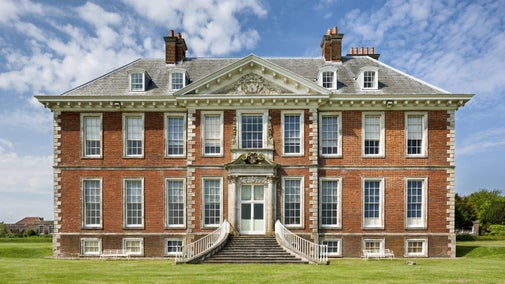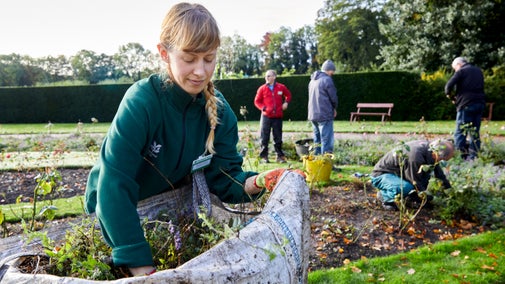
Discover more at Uppark House and Garden
Find out when Uppark House and Garden is open, how to get here, the things to see and do and more.

Free to visit, the intimate and colourful gardens at Uppark offer a variety of different spaces and experiences, including a scented garden, amphitheatre, architectural flourishes and panoramic views across the South Downs.
The garden you see today is from prominent garden designer Humphry Repton, created in around 1810 for Uppark’s then owner Sir Harry Fetherstonhaugh.
Areas of the garden, such as the wide glade, are more heavily influenced by Capability Brown rather than Repton. Although not all of Repton’s plans were implemented, he is thought to be responsible for the Dairy and the Borghese vase on top of the mound at the top of the north drive as well as relocating the main approach to the house to its present-day location. We now garden ‘In the spirit of Repton’ replicating his style of landscape and garden design, but adapting to modern day challenges, including climate change and new pests and diseases. We use more modern, healthy, resilient and adaptable varieties of plants that would have been available to Repton and Late Georgian gardens.
Explore the woodland and meadow walks, awash with hues of orange, red, russet and gold. In the pleasure grounds, silver maple and tulip trees add to the warm Uppark autumnal palette, while in the tea garden the Japanese angelica lends its fiery, vibrant hues once flowering is over. The beautiful pink shades of sedums bring a splash of colour to garden borders.
The woodlands are perfect for an autumn stroll, observing the change in nature and spectacular viewpoints. The treescapes create beautiful canopies of green, yellow and red shades of colour. No leaf is like another, displaying mottled russets and dappled tones.

The amphitheatre garden, planted with attractive herbaceous shrubs and flower borders, was designed to lead guests to the front of the house and the views of the South Downs. There is also a notable collection of trees, set amongst formally mown lawns including conifers and stunning flowering specimens of magnolia and Judas tree.
Maps from the 1870s show an extensive path network weaving between the trees. This was covered over in the 20th century and has now been restored to provide greater access to the garden. The amphitheatre garden is a lovely place to sit on one of the benches and admire the beauty of the garden.
Enclosed by yew hedging, this secluded and intimate area of the garden is planted sympathetically with bulbs and annuals, and a mix of old and new rose varieties, designed to provide scented flowers and foliage throughout the year.
The grass south terraces run along the entire principal front of the house and were the site of formal gardens when the house was first built. In the summer, it is the perfect spot to have a picnic, and to enjoy the views out towards the Solent.
To the south of the house sits the meadow. At its peak in the summer, when it is filled with a variety of wildflowers and butterflies, pathways are cut into the grasses so you can wander right into its heart. Managed in a traditional manner, it is grazed by sheep in the spring and cut for hay in the summer.
Traditionally referred to as ‘The Gothick Seat,’ this ornate covered seating area to the south-east side of the house was most certainly designed by Humphry Repton’s antiquarian architect son, John Adey Repton (c.1811-14). The original colour of the seat is unknown, but this may have been the ‘summer seat’ for the family and their friends to relax on and admire the far-reaching views.
To the left of the gates to the driveway lies a distinctive grassy mound dating from at least the 18th century. It overlooks an open glade surrounded by shrubs and trees, on top of which sits a white Coade-stone Borghese vase. ‘The urn on the mount’, as described by Repton, is partially hidden by box and yew to allow for a delightful surprise when the sun catches the white stone.
Pioneered by the artist and businesswoman Eleanor Coade, the ‘stone’ material is made from a mix of clay, terracotta, silicates and glass and fired for four days, making it hard yet fine enough to carve with the elaborate Greco-Roman relief scene.
Silent Space is a charity that encourages gardens open to the public to reserve an area where visitors can take time to reflect quietly and to enjoy the beauty of the garden and the sounds of nature without distractions.
Uppark’s Garden is small but perfectly formed, overlooking the beautiful South Downs and out to the sea – it’s hard to not feel at peace when you’re here. Further to that, we also have a dedicated space of quiet which can be found in our Scented Garden. A small, hidden part of our garden filled with the beautiful smells and sounds of nature. The area is marked on our visitor maps or do ask a member of the team for directions.
For more information on Silent Space, visit the website
https://silentspace.org.uk

Find out when Uppark House and Garden is open, how to get here, the things to see and do and more.
The grounds at Uppark are free to visit. Come for the spectacular views over the South Downs to the coast, a range of walks and a chance to spot some wildlife.

Find out what family-friendly activities you can enjoy at Uppark House and Garden, from nature trails to theatre events, picnicking to kite-flying.

Take a look inside this classic historical house, filled with exquisite furnishings from all over the world, and discover what life was like below stairs for serving staff.

Uppark is a two pawprint rated place. Take a look at what you need to know if you are bringing your four-legged friend with you on a visit, including walking tips, facilities and information on Pooch Passports.

Explore over 400 years of history, from the early estate to the last owners. Discover when grand decorations and furnishings were added, and substantial renovations took place.

From 18th-century water gardens and Arts and Crafts landscapes to intimate woodland gardens, there are so many places to discover.

Discover our gardeners’ top tips so you can make the most of your garden, plot or window box.
